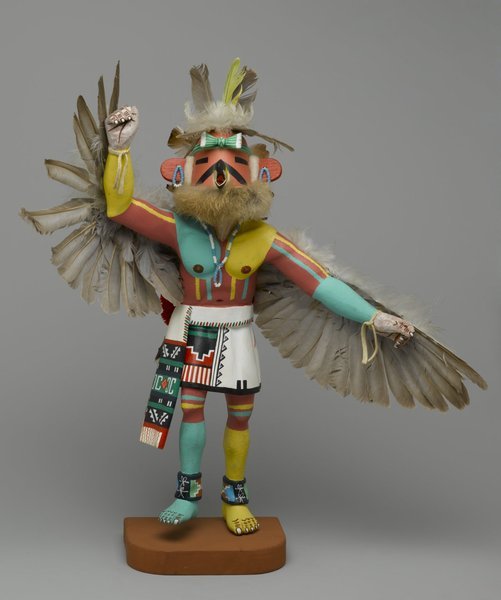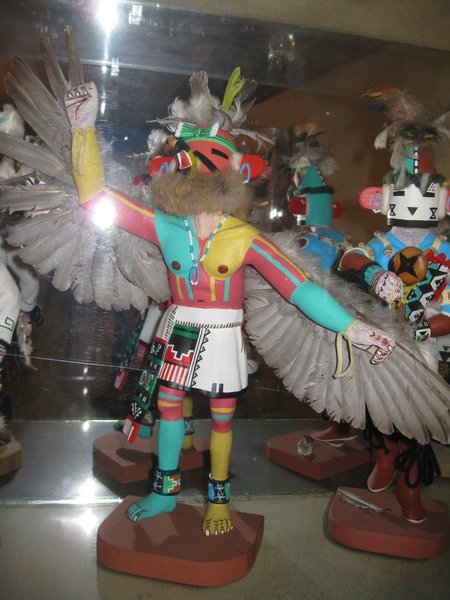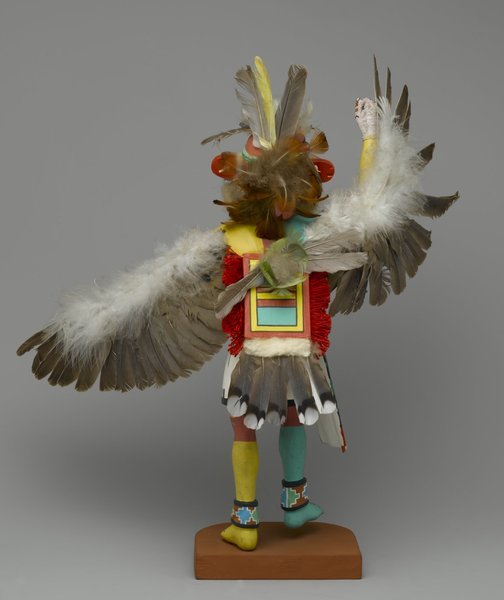Kachina Doll Item Number: 2010.6.10 from the Brooklyn Museum



Description
Eagle Dancer (Kwahu) Kachina Doll. Figure is carved from one piece of cottonwood root. He stands with PR arm raised and PL arm lower with both outstretched with pair of 'eagle' wings on arms and back. Chest is ½ yellow and ½ blue over pink painted body. Arms from elbow to wrist have the opposite colors from the chest. Legs are painted to match the chest. He wears a carved white kilt. He wears a blue and white beaded necklace. The helmet style mask has large, disk-like red ears with cotton stuffed near his head where they are attached and turquoise bead loop earrings. He has a feathered headdress in back on his head. His PR foot is raised. Both feet hare barefoot. His beak is open and you can see his red tongue. Wears a fur ruff around his neck. The eagle dance is a prayer for good crops, rain, and plentiful eagle feathers as their feathers are important in many ceremonies because the bird is thought to be sacred. This Kachina usually appears in a group of several forming a dance troop, squawking and imitating eagle behavior while the Koyemshi (mudhead clowns) sing to them. The sponsoring kiva must fast, abstain from sex, and no eating of salty or fatty foods before the dance.
Credit Line
Gift of Edith and Hershel Samuels
Signed
signed on bottom of base Haenry Shelton Oraibi AZ with an arrow
Label
Kwahu, or Eagle Dancer, usually appears in a troupe of several dancers, spreading feathered wings and squawking and imitating eagle behavior while the Koyemshi (Mudhead Kachinas) sing to him. The sponsoring kiva—a men’s society that holds its meetings in sacred underground spaces—must fast and abstain from sexual relations for a period before the dance. The Eagle Dance is a prayer for good crops, rain, and plentiful eagle feathers. Because the eagle is considered sacred, its feathers are important in many ceremonies.
Kwahu, o Bailarín Aguila, usualmente aparece con una tropa de varios danzantes, extendiendo sus alas emplumadas y graznando e imitando la conducta de las águilas mientras los Koyemshi (Kachinas Cabeza de Barro) le cantan. La kiva auspiciadora – sociedad masculina que se reúne en espacios sagrados subterráneos—debe ayunar y abstenerse de relaciones sexuales por un cierto periodo antes de la danza. La Danza Aguila es una plegaria para recibir buenas cosechas, lluvia y abundancia de plumas de águila. Al ser el águila considerada sagrada, sus plumas son importantes en muchas ceremonias.
Item History
- Made by Henry Shelton between 1960 and 1970
What
- Name
- Kachina Doll
- Identification Number
- 2010.6.10
- Type of Item
- doll
- Material
- cottonwood root, acrylic pigment, feather, hide, fur, bead, yarn and cotton
- Overall
- length 16.5 in, width 14.0 in, height 8.0 in
Who
- Culture
- Pueblo and Hopi
- Creator
- Henry Shelton
Where
- Holding Institution
- Brooklyn Museum
When
- Creation Date
- between 1960 and 1970
Other
- Classification
- Sculpture